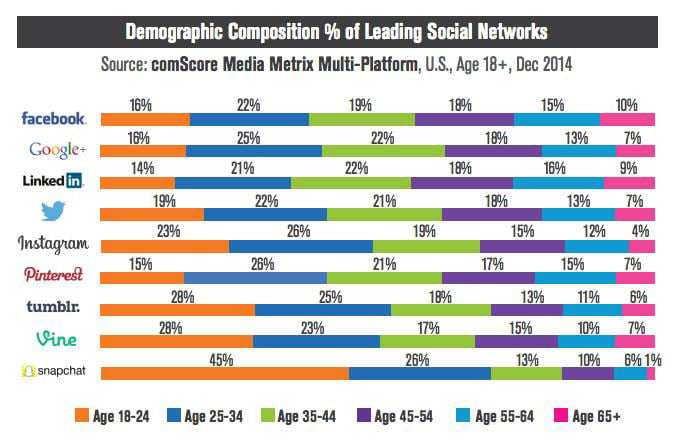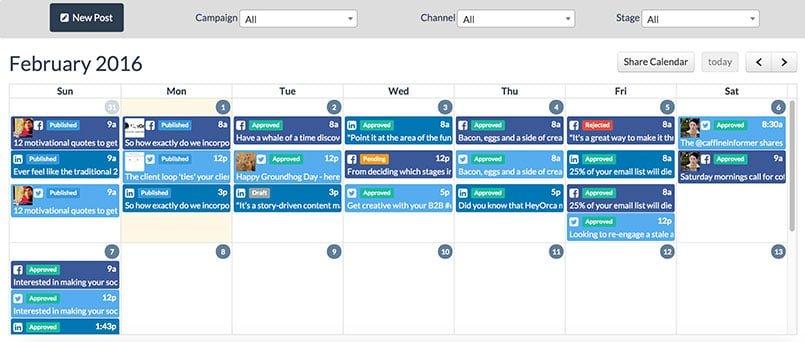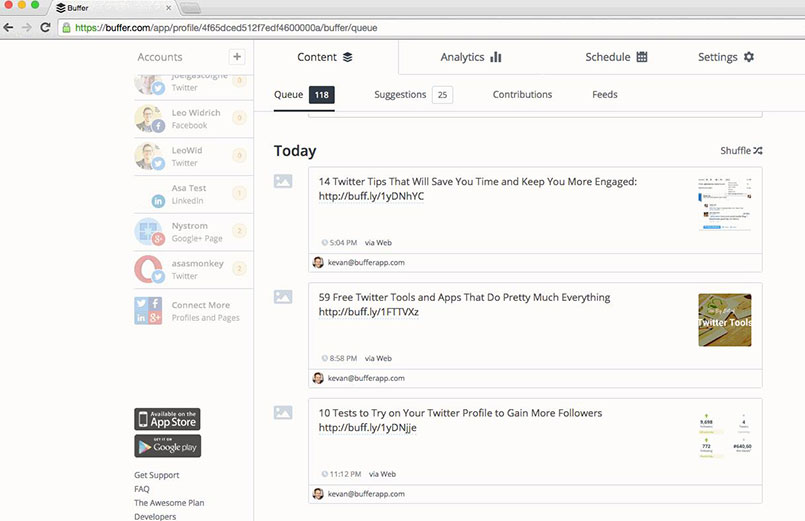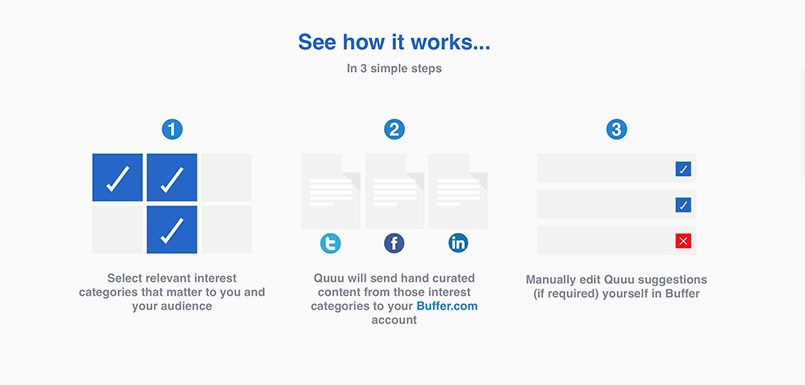Sujan Patel
Social media is an area where many .orgs come up short. In fact, it’s common for a lot of businesses to stumble with social media outreach. A new organization might have a handle on its social media campaigns, but as its audience grows, social media transforms into something that requires more time and attention.

Organizations often make the mistake of assigning social media to a volunteer or staff member already burdened with other tasks, and they don’t take the time to make posts geared toward the right audience..
Another common mistake is to split the duties across multiple volunteers. This can be effective, but only if you have a very precise and defined workflow, and a team with strong internal communication.
Finding the people with the right skill set is just as important as finding people who are interested in helping. Volunteers that aren’t interested in social promotion and would prefer to be helping somewhere else can have a negative impact on your social outreach.
Here’s how you can streamline your social media to make it easier to manage, improve engagement, grow your donor network, and garner more support from followers.
How to Use Social Media to to Attract and Engage Donors and Supporters

Step 1: Build Out a Content Calendar
Most organizations don’t have any real plan in place for posting content to their social profiles. Posts are made on the fly when someone sends off an email and says, “We should make a post about…”
When posts are made, they generally involve updates about events, donor support, and media relations for the organization.
They typically don’t provide additional value, and tend to be reactionary.

A content calendar is a great way to plan the bulk of your content for the coming weeks and months. At a glance you can see what posts are coming up, and everyone in the organization with access – like your marketing team and leadership – can stay in the loop.
Creating a content calendar is extremely easy; a simple calendar template in a spreadsheet is sufficient. Using a Google Calendar shared with your team is also a great option.
What Goes in the Calendar?
Setting up your calendar each month is easy:
- Decide how often you’re going to make posts
- Decide which channels you’re going to use
- Brainstorm a list of topics to be covered
- Build relevant holidays in your content schedule
- Split those topics across various channels
- Each day you post, make an entry that lists the channel, topic, and the time for the post
As you complete and publish posts, mark them off on your calendar with a strikethrough.
The greatest benefit of a content calendar is that you have a consistent, set schedule for when content goes live. The calendar includes the gist of every social post, and relevant links. That means that anyone can step in to make sure you’re producing regular, engaging content.
If you want to unburden your volunteers, a virtual assistant can be brought on to handle getting content live. The goal is to streamline content distribution to improve engagement while freeing up your staff.
Deployment can even take place in stages, where your team sources and loads topics while an assistant handles the content posts. In time, your VA will learn to identify relevant content and can source topics to assist with populating your content calendar.
Step 2: Integration With the Right Tools
Using a calendar to plan content can save you a lot of scrambling in the future, but if you want to preload any content, you have to do it manually channel by channel. This can be incredibly time consuming.
Curating content that provides value to your audience can also eat up a great deal of time, but it’s necessary to share things outside of what you create.
Thankfully, there are a number of tools you can use to help further streamline the sourcing, management, and scheduling of your social content.
Buffer – Buffer is a terrific tool that allows you to schedule content to be posted at a later time across major social networks like Twitter, Facebook, and LinkedIn. You can create the posts or curate links, set the date and time, and that’s it. Once the scheduled time hits, the content is pushed to your social channels.

Buffer also has a browser extension. If you find a terrific article, video, or image you want to share with your audience, you can add it to your queue with a single click.
Hootsuite – Hootsuite has long been a popular application for managing multiple accounts. While Buffer is geared towards scheduling content, Hootsuite allows you to monitor, post, and respond to all of your social channels through a single interface. This is incredibly helpful if you’re working with multiple social accounts and need to get posts out to each multiple times a day, while also responding to followers.
The mobile application provides the same flexibility, so if you’re on the road or at an event, you can still maintain full and efficient control over your social channels.

Quuu – Quuu is a great tool you can use to fill the gaps in your content calendar and eliminate the extra time spent on sourcing and curating content. You can mark categories that are most relevant to your audience, and Quuu will hand-pick high-quality articles for you. The best part is that Quuu integrates with Buffer, so it will automatically load content into a queue to be scheduled for publication.
Here’s the cherry on top: while each of these services has a premium version, they’re all completely free to use. You can integrate them into your social strategy to see how they streamline your social outreach, and upgrade if you feel the value is there.
Because of the mobile nature of each of these tools, a virtual assistant can fully manage the integration. That includes queue monitoring and keeping hours trimmed by using a platform like Hootsuite to reduce the amount of time spent monitoring, posting, and responding.

Step 3: Create Amazing Content
One of the areas where a lot of organizations botch their outreach is by creating content that is too promotional. When all you’re doing is asking for the sale, requesting donations, and trying to push people to take action, your audience will begin to shut it out, much the same way we tune out interruptive marketing like commercials and banner ads online.
If you want more engagement from your supporters, and to grow your following, then you have to take a more creative and value-oriented approach to the content you post.
Typically, businesses follow the 80/20 rule with social media: 80% of your content should focus on providing value and be informative or educational with zero ties to promotion. Special offers, sales, etc. should be limited to the remaining 20% of content.
For a non-profit, the approach is a little different. Your approach should follow the Rule of Thirds:
- 1/3 Appreciation
- 1/3 Advocacy
- 1/3 Appeals
Appreciation: sharing valuable, informative content with fans and showing appreciation for their support and donations
Advocacy: sharing valuable content around the mission of the non-profit
Appeals: requesting donations and donor outreach, including leveraging influencers and utilizing storytelling to sink the message
If you work with a virtual assistant who has prior skills in managing social campaigns, you’ll be able to move away from too-frequent event posts and solicitations to create more variety in your content.
When you focus on providing more value, you’ll see more engagement and more donor support in return.
Step 4: Start Engaging
Posting content isn’t enough, and only makes up a small portion of the time spent on social media. The meat of it will be in the direct engagement that happens with your followers. Responding to comments, as well as engaging other pages and influencers, not only keeps your current fans engaged but helps draw new supporters and donors to your cause.
Here’s what you should do:
- Take time each day, a few times a day, to respond to comments from followers
- Post to other pages as your .org page; focus on the ones with some relevancy to your cause
- Find and engage influencers in social; respond to their posts and share their content with your followers

Make sure you stay active every day and respond to everyone. If your followers feel like you’re not engaging them, they’ll eventually lose interest and stop commenting and reacting to your content.
Conclusion
When social media is managed effectively and efficiently, using the steps above, it can be a very productive and low-cost means for acquiring donors and support. The only real cost is the time it takes to create your strategy, and the resources you commit to its execution. With a virtual assistant, you have a hands-free approach to consistent outreach that will keep your supporters engaged and help generate new interest for your cause.
Find this article helpful?
This is just a small sample! Register to unlock our in-depth courses, hundreds of video courses, and a library of playbooks and articles to grow your startup fast. Let us Let us show you!
Submission confirms agreement to our Terms of Service and Privacy Policy.